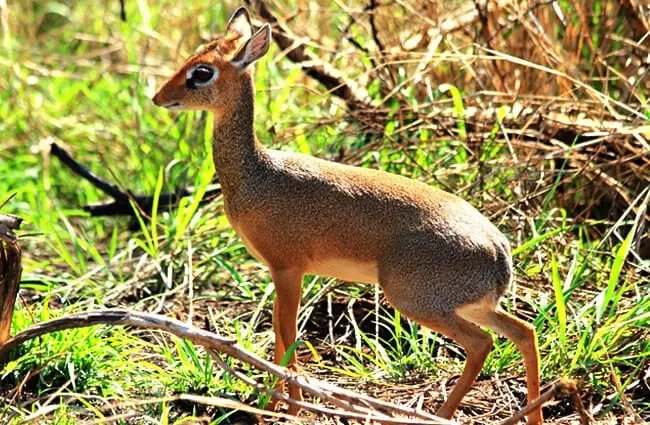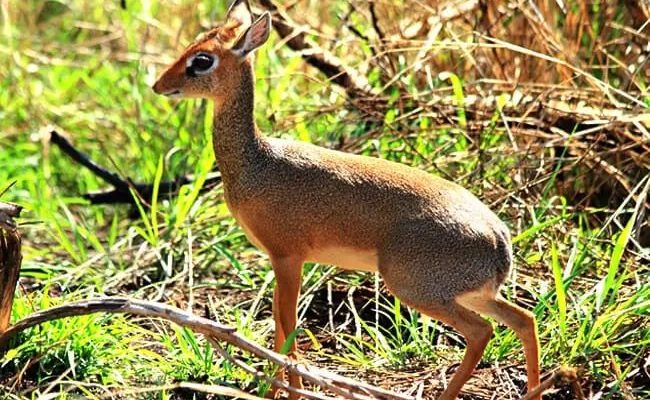
Imagine you’re at a gathering where people share similar styles—short stature, long legs, and great postures. It’s hard to keep track of who’s who. Well, the animal kingdom has its own version of this, and that’s what we’ll explore. We’ll dive into ten animals that resemble dik-diks, giving you the lowdown on how to recognize each one. So, grab a cup of coffee and let’s get to know these fascinating creatures a bit better!
1. Springbok
Let’s start with the springbok. These gracefully built antelopes are somewhat larger than dik-diks, reaching around 2 to 3 feet at the shoulder. One of their most striking features is their incredible jumping ability. You might see a springbok leap up to 10 feet in the air! Unlike dik-diks, which prefer dense brush, springboks thrive on open plains and are often found in herds. They have a distinctive white stripe along their sides and a brownish coat that helps them blend into the savannah.
The behaviors of springboks also set them apart. When threatened, they don’t just run; they perform a unique display called “pronking,” where they leap high into the air. It’s quite a sight! In contrast, dik-diks tend to freeze in place or dash for cover in brush. So, if you see a small herd of antelopes gracefully bouncing around in the wild, you’re likely watching springboks rather than dik-diks.
2. Impala
Next up is the impala, another graceful antelope. Impalas are larger than both dik-diks and springboks, standing around 3 to 3.5 feet tall at the shoulder. They’re known for their impressive agility, much like springboks, and can leap up to 10 feet in a single bound! The impala’s coat is a reddish-brown color with white underparts, giving it a sleek and shiny appearance.
While dik-diks are solitary or found in pairs, impalas are highly social animals that form large groups, sometimes numbering in the hundreds. This social behavior helps them spot predators more effectively. If you’re out in the savanna and see a big group of antelopes elegantly frolicking together, you’re looking at impalas, not dik-diks!
3. Klipspringer
Then we have the klipspringer, a smaller member of the antelope family. These little guys stand about 2.5 feet tall and have a compact, muscular body built for navigating rocky terrains. Their name translates to “rock jumper” in Afrikaans, and it’s fitting—they’re excellent climbers! Unlike dik-diks, klipspringers have a more robust build and are often found in pairs on steep cliffs or rocky outcrops.
One of the key features of klipspringers is their unique hooves, which are small and flexible. This adaptation enables them to grip rocky surfaces. If you see an antelope with a sturdy body perched on a rocky ledge, it’s likely a klipspringer, not a dik-dik!
4. Puku
Moving on, let’s meet the puku. This medium-sized antelope can be found primarily in wetlands and floodplains of Zambia and Botswana. They stand at about 2.5 to 3 feet tall and have a brownish coat with lighter underparts. What sets them apart is their affinity for watery areas—unlike dik-diks, which prefer dry bushland.
Puku antelopes are social animals that live in groups, particularly during the rainy season. They have a distinctive, slightly elongated face compared to dik-diks. If you spot a group of antelopes grazing near water, you might just be looking at puku, not dik-diks.
5. Suni
Next on the list is the suni, a relatively small antelope found in the forests of East Africa. They are similar in size to dik-diks, standing around 1.5 to 2 feet tall. The suni is known for its reddish-brown coat and white stripes on its face and legs. However, unlike the dik-dik, the suni prefers dense forest habitats.
Suni are elusive creatures and tend to be shy, often hiding in thick vegetation. This makes them a bit harder to spot than dik-diks, which are more accustomed to open areas. If you find yourself trekking through a lush forest and catch a glimpse of a small, shy antelope with a beautiful coat, it could very well be a suni!
6. Gerenuk
Let’s take a look at the gerenuk, also known as the “long-necked gazelle.” This antelope has a distinctly long neck, which helps it reach high branches for leaves. Gerenuks are taller and leaner than dik-diks, often reaching up to 3 feet at the shoulder. Their striking features include a slender body and large, expressive eyes.
One fascinating behavior of gerenuks is their ability to stand on their hind legs to graze on leaves. This is quite different from dik-diks, which primarily browse at lower levels. If you see an antelope effortlessly munching on tree branches while standing upright, you’re likely looking at a gerenuk.
7. Hartebeest
Another antelope worth mentioning is the hartebeest. These animals are larger than dik-diks, standing around 3.5 to 4 feet tall. They have a unique, elongated face and long legs, making them easily recognizable. The hartebeest boasts a reddish-brown coat and often has darker patches on its body.
What truly sets hartebeests apart is their social structure. They often form large herds, which can help them defend against predators. Unlike dik-diks, which are generally more solitary, hartebeests thrive in groups. If you see a large gathering of tall antelopes with unique features, you’ve likely stumbled upon a herd of hartebeests.
8. Oribi
Let’s not forget the oribi, a small and nimble antelope native to eastern and southern Africa. Standing at around 2.5 feet tall, oribis have a reddish-brown coat and a white face and underbelly. They prefer grasslands and are known for their excellent running speeds, making them quite agile.
Oribis are social creatures but often form smaller groups than some of their relatives. They have a more slender build compared to dik-diks and are generally quicker and more agile in the open. So, if you see a small, quick-moving antelope darting through grasslands, it might just be an oribi rather than a dik-dik.
9. Bongo
Lastly, let’s talk about the bongo, a larger antelope found in the rainforests of Central and West Africa. Bongos are striking with their reddish-brown coats and white stripes. They stand much taller than dik-diks, reaching about 3 to 4 feet at the shoulder, and are known for their large, curved horns.
What really sets bongos apart is their forest-dwelling nature. While dik-diks favor open bushlands, bongos thrive in dense, tropical forests. They tend to be more elusive and are often nocturnal, making them a rare sight. If you find yourself deep in the forest and spot a large, striped antelope, you’ve likely encountered a bongo!
10. Kudu
Finally, let’s meet the kudu, a large antelope known for its impressive spiral horns and standing around 4 to 5 feet tall at the shoulder. Kudus have a greyish-brown coat with white stripes that enhance their striking appearance. Unlike the compact dik-dik, kudus are more robust and prefer savannahs and woodlands.
One interesting trait of kudus is their ability to blend into their surroundings, making them difficult to spot in the wild. They are generally solitary or found in small groups. So, if you see a large, majestic antelope with impressive horns, it’s probably a kudu rather than a dik-dik!
In summary, the world of antelopes is diverse and fascinating. Although dik-diks are charming and unique, they share their habitats with several other animals that may look similar but have their distinct traits and behaviors. By recognizing these differences, you can appreciate the richness of wildlife around you. So, the next time you venture into the wild, keep an eye out for these delightful creatures and enjoy the beauty of nature!

